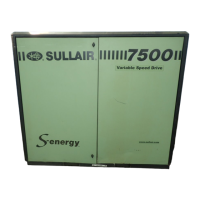SECTION 4 4500P-7500 USER MANUAL
53
4.3 SERVICE AIR PIPING
Before installing the compressor, review the service
air system’s layout including: pipe sizes, auxiliary
receiver, drip legs, line filter(s), and isolation valves
(See Figure 4-1).
PIPE SIZING
Pipes should be sized as a minimum to match the
dimensions of the compressor’s discharge
connection. All piping and fittings should be rated for
the discharge pressure.
AUXILIARY RECEIVER TANK
An Auxiliary receiver tank should be installed in
systems where large demand fluctuations will occur.
ISOLATION VALVES
Install isolation valves where isolation of the
compressor from the service lines is required. These
valves should have drip legs that drain at an angle
downward from the base. A vent to the piping should
be installed downstream of the compressor outlet
connection.
When two compressors are installed to operate in
parallel with a common receiver tank, an isolation
valve and drain trap for each compressor should be
installed before the common receiver.
Compressors have built-in aftercoolers and are
equipped with a condensate drain located next to the
air outlet connection. A drain line should be installed
to remove the condensate, which builds up during
compressor operation. See Figure 4-2.
NOTE
Compressors not equipped with an auxiliary
receiver tank may need to have their response
times adjusted. Contact Sullair Customer Care
for assistance.
1. Compressor
2. Sullair Dryer
3. Shut-Off Valve (Gate Valve Recommended)
4. Air Outlets (Never Take Air From Bottom of
Pipe)
5. Water Leg
6. By-Pass Gate Valves
Figure 4-1 Typical Service Air Piping

